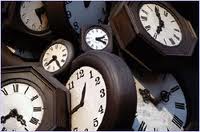‘If a place can be defined as relational, historical and concerned with identity, then a space which cannot be defined as relational, or historical, or concerned with identity will be a non-place’ (Augé 1995, p. 77), if a building possesses ‘non-place’ characteristics then it is there to only serve a purpose rather then add something to a community or an area.
In an ever growing fast paced world, the essence of character and legacy can be seen as depleting and being replaced by service based infrastructure that holds no personality, such as airports and shopping malls. These places are blamed for setting people up on the mundane conveyor belt of life. These places have no character and they do not create experiences or provoke emotion such as churches or battle grounds. It is worth mentioning that a ‘place’ or a ‘non-place’ does not necessarily have to be a building but any area of space, like a motorway for example.
Although I agree that when the essence of the past is present in a building, or a room or even a road, it does create a different atmosphere and a sense of identity. We all know of that back road to that certain place that has the really scary trees and the old broken wooden fence running alongside it, which fills us with memories and atmosphere every time we drive down it, and often we give it an identity by naming it. In turn it is evident that modern places still have their own stories and are filled with people who have their own experiences. An airport can be perceived as ‘Everyday spaces of Late-Capitalist cities’ (Coyne), can be seen as a vacuous filtering system of people, or you could look at the individuals. Each passenger has their own story of why they are there and their own influence on the space. People develop memories and experiences at airports all of which add to the identity and character of the place. Furthermore, the members of staff that work there every day become part of the building and bring a whole new type of character to the building. The beautiful thing about these large places, filled with forever changing people, is that they can be filled with so much more experience and character than any historical site, and on top of that they have the ability to change their identity so significantly and so often, which makes them more of a ‘place’ than a lot of the places Augé would perceive as a ‘place’.
When first looking into Gallery 3 at the Usher gallery you see all these pieces of art and watches with an abundance of history and fascinating stories, which simply epitomises the idea of a ‘place’. Despite this, if you think about it closer, Gallery three is just another gallery conforming to what can only be perceived as a normal museum gallery. It is dark, small and has little writing explain the stories which would indeed truly make it a ‘Place’, compared to the Collection, it can be perceived as somewhat flaccid and thus has another product of what museums should be.
‘Place and non-place are rather like opposed polarities: the first is never completely erased, the second never totally completed…’ (Augé 1995, p. 79), this not only insists that there is hope for our airports to one day been seen as a ‘place’, but also our fully cultured, fully historical churches once started off as a ‘non-place’ and still contains ‘non-place’ characteristics. Moreover, this shows that a building will never reach its full identity, its context and essence can only ever grow. I believe that the speed in which a ‘non-place’ can become a ‘place’ is heavily down to the acceptance of the build in the community, alongside with its actual aesthetic beauty. Take a motorway for example. A town may totally hate it because it has left a ‘scar’ on the landscape and has no positive externalities for that town, whereas it could actually be seen as a compliment to that town and become a big part of it, not only bringing ease of access to that town but also, in time, it can build a new history more fulfilled history and new experiences made with journeys taken on it.
Airports can be seen as a plain large glass blister on the earth just ferrying people in and out, but these people give them more character than any type of brick or mystical stories. I disagree with those who think that airports or shopping malls are ‘non-places’ because they do not ‘identify a loss of personal identity’, or a, ‘decline in meaningful relations amongst the users of spaces’ (Coyne). Despite this it can easily be argued that each member of staff sees each customer as just another number. In turn each customer can see the staff as just mere faces of the company they may be dealing with, ‘The non-place is the opposite of utopia: it exists, and it does not contain any organic society’ (Augé 1995, p. 111-112). Although I still believe, and have experienced, that people in these places genuinely want to help you and create an experience for you which may not be received from a ‘place’ steeped in cultural history, because of the vast size of these spaces, and the volume in which people are dealing with, going to these ‘non-places’ can be seen as a process as opposed to an experience.
Essentially i do not think ‘non-places’ really ever exist, no matter how young the space is, people are forever having influence on everywhere they go and these ‘places’ never have a chance to be a ‘non-place’. Our task is to see if we can re-insert life back into Gallery 3 and give it an extra story to tell.
Written by: Shane Humberstone
Works Cited:
Augé, Marc (1995) Non-Places: Introduction to an Anthropology of Supermodernity, trans. John Howe, London and New York: Verso.
Coyne, Richard Orienting the Future: Design Strategies for Non-Place, Online: http://www.design21.dundee.ac.uk/PDF/NonPlace.pdf (accessed 3 April 2013)



